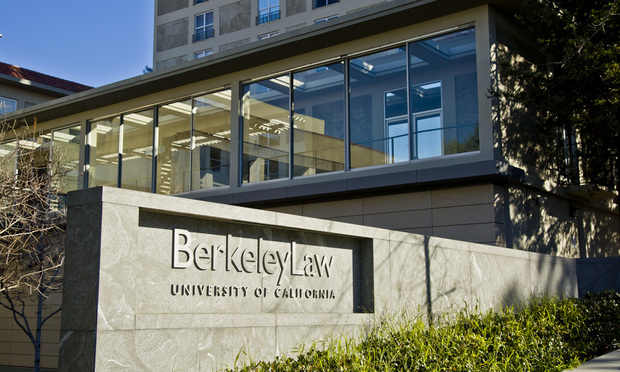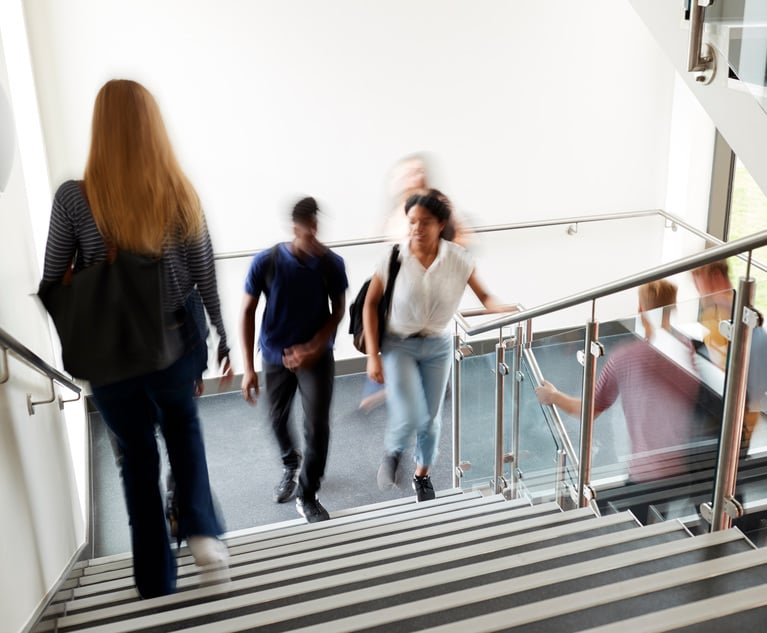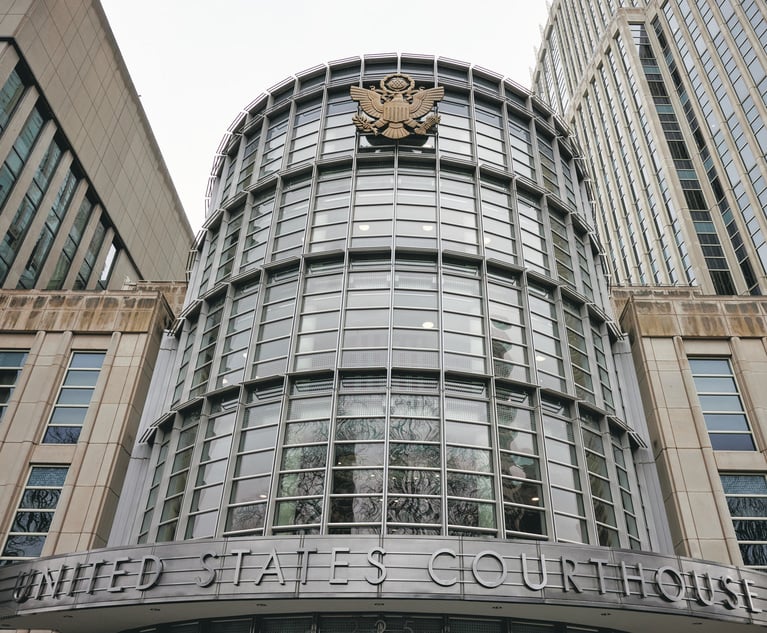Berkeley Law Returns to the U.S. News' Top 10, Pepperdine Gets Shut Out
The closely watched law school rankings offer few surprises this year, save for a decision to temporarily delist Pepperdine University School of Law for an data reporting mistake.
March 20, 2018 at 12:01 AM
9 minute read
The original version of this story was published on Law.com

The University of California, Berkeley School of Law is one of the big winners in this year's U.S. News & World Report law school rankings, released Tuesday.
Berkeley moved up three spots to No. 9, regaining its position in among the top 10 schools—a perch it temporarily lost last year when it slipped four positions to No. 12. Otherwise, the new list offers relatively little drama among the elite schools.
Yale retained its longstanding spot at No. 1, followed by Stanford Law School at No. 2, and Harvard Law School at No. 3. There were no changes in rank among the top eight schools. Harvard is followed by the University of Chicago Law School; Columbia Law School; New York University School of Law; the University of Pennsylvania Law School; and the University of Michigan Law School.
The University of Virginia School of Law fell one spot to tie Berkeley at No. 9. While Duke Law School and Northwestern University Pritzker School of Law—which each tied at No. 10 last year—both lost one spot to land just outside the top 10.
Georgetown University Law Center and the University of Texas School of Law traded places for the second straight year, with Georgetown regaining its usual place at No. 14 and Texas falling to No. 15.
Berkeley officials attributed the school's previous ranking decline to fallout from former dean Sujit Choudhry's sexual harassment controversy. Its strong performance this year can be attributed to a slight increase in the school's Law School Admission Test scores, as well as an uptick in graduates with jobs lined up at graduation.
Berkeley's restoration to U.S. News' top 10 wasn't the only triumph this year for the Bay Area school's current dean, Erwin Chemerinsky. The University of California, Irvine School of Law, where Chemerinsky was dean until this fall, rose seven spots to No. 21. The Orange County school is now tantalizingly close to cracking the top 20, which Chemerinsky set as an ambitious goal when he founded the school in 2007. (Irvine debuted in the rankings at No. 30 in 2015.)
“I have a skepticism about rankings, but my goal from the outset was that UCI Law School be in the top 20 and I am thrilled to see it ranked 21,” Chemerinsky said. “It reflects its terrific faculty, students, and program.”
U.S. News' annual rankings are always met with complaints from legal educators who charge that they take a one-size-fits-all approach to measuring law schools and don't accurately reflect the quality of each school. But law deans are also loath to ignore the rankings, which play an outsized role in the admissions landscape. Unlike business schools, which are ranked by multiple national publications, U.S. News is the only major player in law school rankings.
This year's list has a little extra controversy.
U.S. News removed Pepperdine University School of Law from the ranking after the school reported a mistake in the median LSAT score it provided to the publication. According to Pepperdine law dean Paul Caron, the school last week realized that it had incorrectly reported its median LSAT score as 162 instead of the correct 160 when it saw the early embargoed version of the rankings that U.S. News provides each school for review. (The initial ranking had Pepperdine moving up from No. 72 to No. 59.)
Rather than recalculate the school's rank and issue a new list prior to the official release, as the Caron requested, U.S. News removed Pepperdine's ranking altogether.
“It is, of course, deeply disappointing to be unranked for a year,” Caron wrote in a post on his Tax Prof Blog. “But the reality is that we made great progress in the rankings this year, and should continue our ascent next year.”
Caron said several experts concluded that Pepperdine would have ranked 62nd or 64th using the correct median LSAT.
University of Chicago law professor Brian Leiter, a frequent critic of law school rankings, said on his blog that U.S. News' handling of the situation will dissuade law schools from disclosing any inadvertent mistakes in their data.
“No good deed goes unpunished by [U.S. News Chief Data Strategist] Bob Morse & Co.,” Leiter wrote.
Morse said that U.S. News handles misreported data on a case-by-case basis.
“It is worth noting that Pepperdine did complete the data verification process during the data collection for law schools, assuring U.S. News that its information was accurate,” Morse said. “We do rely on schools to accurately report their information, and we thank them for their cooperation and efforts in doing just that.”
As is typical, most of the major moves among schools occurred outside of the top 50.
The University of Maine School of Law posted the single largest gain this year, moving up 33 spots to No. 106. That move comes one year after the school plummeted 28 spots on last year's list. That volatility illustrates how the U.S. ranking fails in accurately assessing small law schools that feed relatively limited legal markets, said dean Danielle Conway.
“Maine Law has always been one of the smallest law schools in the country, with fewer than one hundred graduates each year; thus, each individual graduate represents more than a percentage point in many of the metrics used to calculate the rankings,” she said. “As a result, even small changes in our numbers—plus or minus—are unduly magnified.”
Conway suggested that it would make more sense for the U.S. News rankings to be based on three-year averages of each school's data.
This year, Maine reported significantly higher graduate employment rates and a slightly higher 25th percentile LSAT score.
The second-largest jump this year was Santa Clara University School of Law which shot up 19 spots to become No. 113, due in part to an improved median undergraduate grade-point average, and better graduate employment and bar pass rates.
“We are excited by our momentum, including the debut of [the school's new campus] Charney Hall,” said law dean Lisa Kloppenberg. “The increase reflects our emphasis on preparing students well for our market and improving employment opportunities, plus greater support from the university, alumni and friends.”
Among the other big gainers were: The University of Denver Sturm College of Law, up 13 to No. 63; the University of Miami School of Law, up 12 to No. 65; Villanova University Charles Widger School of Law, up 12 to No. 65; the University of New Hampshire School of Law, up 15 to No. 85; Cleveland-Marshall College of Law, up 14 to No. 113; and the University of South Dakota School of Law, up 14 to No. 128.
Belmont University College of Law and the University of Dayton School of Law both moved out of U.S. News' unranked second tier to become No. 139 and No. 141, respectively.
Meanwhile, plenty of schools saw their rankings decline significantly.
Drake University Law School saw the largest decline, falling 27 spots to No. 133. Dean Jerry Anderson said he could not account for that change, and the program is “as strong as it was last year.” Data supplied to U.S. News shows a decline in the school's graduate employment and bar pass rates. Anderson said the school's employment and bar pass rates are higher than the national average, but Drake is refining its bar preparation and career services programs nonetheless.
“These rankings do not reflect who we are any more than the daily horoscope accurately predicts your future,” he said.
The University of Nebraska College of Law had the second-largest decline. Falling 23 spots to No. 80.
“I would suggest that the ranking is focused on the wrong metrics.,” said law dean Richard Moberly. “Nebraska Law has not changed fundamentally from the school we were last year when we were 57. When a school with the 19th highest bar passage rate and one of the lowest tuitions in the country falls to number 80, students should question whether any ranking can truly capture the relative value of an individual law school.”
Among the other major decliners are: The University of San Diego School of Law, down 18 spots to No. 95; the University of Tulsa College of Law, down 19 spots to No. 101; the University of Louisville Louis D. Brandeis School of Law, down 21 spots to No. 113; and the University of Wyoming College of Law, down 21 spots to No. 133.
Loyola University New Orleans School of Law; Samford University Cumberland School of Law; the University of North Dakota School of Law; the University of Pacific McGeorge School of Law; and Willamette University College of Law joined the unranked second tier this year.
Arizona Summit Law College and Thomas Jefferson School of Law did not receive ranks this year because they were on probation with the American Bar Association as of February. U.S. News did not rank Whittier Law School because it Is in the process of shutting down and did not admit new students last fall.
U.S. News' methodology largely stayed the same this year, though it “slightly reduced” the discount it applies to graduate jobs that are funded by the law schools themselves in its calculation of employment rates.
Forty percent of each school's ranking is based on reputational assessments by legal academics, lawyers and judges. The median LSAT score and undergraduate grade-point averages account for another 25 percent, while job placement and bar pass rates are 20 of a school's score. Faculty resources comprises the final 15 of each school's rank.
This content has been archived. It is available through our partners, LexisNexis® and Bloomberg Law.
To view this content, please continue to their sites.
Not a Lexis Subscriber?
Subscribe Now
Not a Bloomberg Law Subscriber?
Subscribe Now
NOT FOR REPRINT
© 2025 ALM Global, LLC, All Rights Reserved. Request academic re-use from www.copyright.com. All other uses, submit a request to [email protected]. For more information visit Asset & Logo Licensing.
You Might Like
View All
The Met Hires GC of Elite University as Next Legal Chief

NY Appellate Panel Cites Student's Disciplinary History While Sending Negligence Claim Against School District to Trial

'No Evidence'?: Big Law Firms Defend Academic Publishers in EDNY Antitrust Case
3 minute read
'Substantive Deficiencies': Judge Grants Big Law Motion Dismissing Ivy League Price-Fixing Claims
3 minute readTrending Stories
- 1'It's Not Going to Be Pretty': PayPal, Capital One Face Novel Class Actions Over 'Poaching' Commissions Owed Influencers
- 211th Circuit Rejects Trump's Emergency Request as DOJ Prepares to Release Special Counsel's Final Report
- 3Supreme Court Takes Up Challenge to ACA Task Force
- 4'Tragedy of Unspeakable Proportions:' Could Edison, DWP, Face Lawsuits Over LA Wildfires?
- 5Meta Pulls Plug on DEI Programs
Who Got The Work
Michael G. Bongiorno, Andrew Scott Dulberg and Elizabeth E. Driscoll from Wilmer Cutler Pickering Hale and Dorr have stepped in to represent Symbotic Inc., an A.I.-enabled technology platform that focuses on increasing supply chain efficiency, and other defendants in a pending shareholder derivative lawsuit. The case, filed Oct. 2 in Massachusetts District Court by the Brown Law Firm on behalf of Stephen Austen, accuses certain officers and directors of misleading investors in regard to Symbotic's potential for margin growth by failing to disclose that the company was not equipped to timely deploy its systems or manage expenses through project delays. The case, assigned to U.S. District Judge Nathaniel M. Gorton, is 1:24-cv-12522, Austen v. Cohen et al.
Who Got The Work
Edmund Polubinski and Marie Killmond of Davis Polk & Wardwell have entered appearances for data platform software development company MongoDB and other defendants in a pending shareholder derivative lawsuit. The action, filed Oct. 7 in New York Southern District Court by the Brown Law Firm, accuses the company's directors and/or officers of falsely expressing confidence in the company’s restructuring of its sales incentive plan and downplaying the severity of decreases in its upfront commitments. The case is 1:24-cv-07594, Roy v. Ittycheria et al.
Who Got The Work
Amy O. Bruchs and Kurt F. Ellison of Michael Best & Friedrich have entered appearances for Epic Systems Corp. in a pending employment discrimination lawsuit. The suit was filed Sept. 7 in Wisconsin Western District Court by Levine Eisberner LLC and Siri & Glimstad on behalf of a project manager who claims that he was wrongfully terminated after applying for a religious exemption to the defendant's COVID-19 vaccine mandate. The case, assigned to U.S. Magistrate Judge Anita Marie Boor, is 3:24-cv-00630, Secker, Nathan v. Epic Systems Corporation.
Who Got The Work
David X. Sullivan, Thomas J. Finn and Gregory A. Hall from McCarter & English have entered appearances for Sunrun Installation Services in a pending civil rights lawsuit. The complaint was filed Sept. 4 in Connecticut District Court by attorney Robert M. Berke on behalf of former employee George Edward Steins, who was arrested and charged with employing an unregistered home improvement salesperson. The complaint alleges that had Sunrun informed the Connecticut Department of Consumer Protection that the plaintiff's employment had ended in 2017 and that he no longer held Sunrun's home improvement contractor license, he would not have been hit with charges, which were dismissed in May 2024. The case, assigned to U.S. District Judge Jeffrey A. Meyer, is 3:24-cv-01423, Steins v. Sunrun, Inc. et al.
Who Got The Work
Greenberg Traurig shareholder Joshua L. Raskin has entered an appearance for boohoo.com UK Ltd. in a pending patent infringement lawsuit. The suit, filed Sept. 3 in Texas Eastern District Court by Rozier Hardt McDonough on behalf of Alto Dynamics, asserts five patents related to an online shopping platform. The case, assigned to U.S. District Judge Rodney Gilstrap, is 2:24-cv-00719, Alto Dynamics, LLC v. boohoo.com UK Limited.
Featured Firms
Law Offices of Gary Martin Hays & Associates, P.C.
(470) 294-1674
Law Offices of Mark E. Salomone
(857) 444-6468
Smith & Hassler
(713) 739-1250






